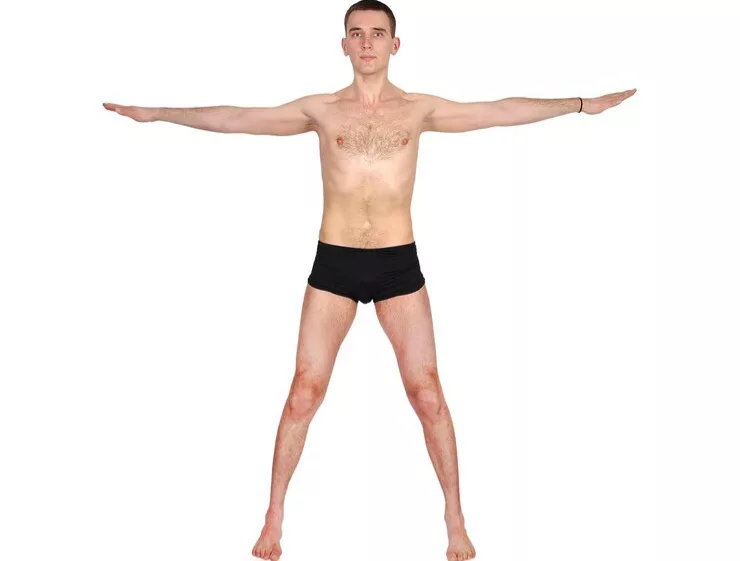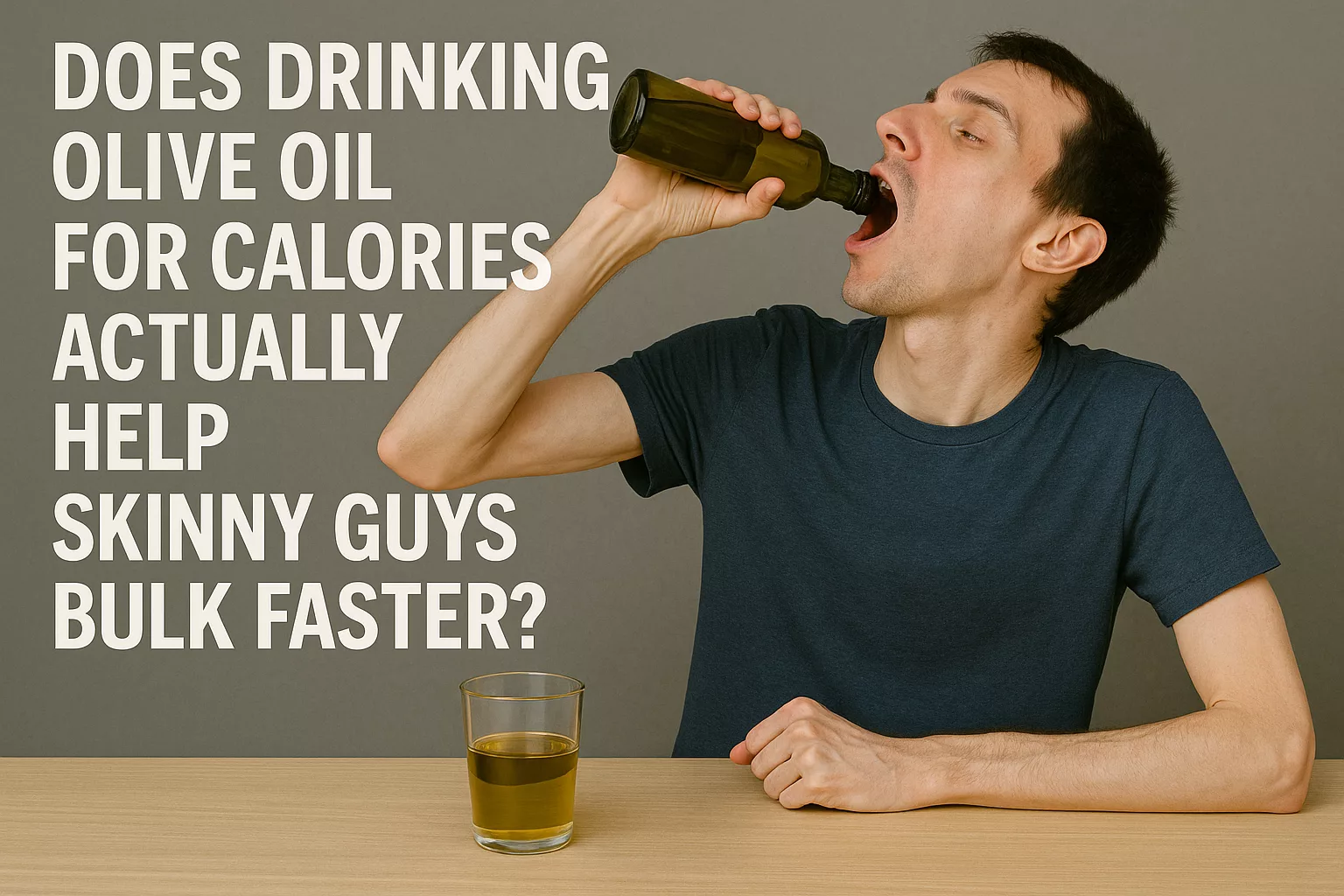Let me tell you straight: if you’re one of those people who still gets called “skinny” at Christmas after eating two panettones, this article is for you.
Yes, you read that right.
We’re talking about drinking olive oil.
Not as a dressing.
Not drizzled over a slice of bread.
Straight up, like it’s a magic potion to pack on mass.
And as much as it sounds like advice from your crazy uncle in a tank top, there’s some surprising truth behind it.
Actually, more than one.
The hardgainer’s curse: you eat but don’t gain

Being a “hardgainer” isn’t a lifestyle. It’s a genetic curse.
You eat — I swear, you eat.
You’ve tried increasing portions.
You’ve had three snacks between lunch and dinner.
You’ve even tested the physical limits of your jaw with 400 grams of rice in one sitting.
And still, nothing.
The scale stays put.
Mocking you.
Because your metabolism runs like it’s got a turbo engine.
And your appetite can’t always keep up.
That’s where the idea of liquid calories comes in.
Calorie-dense.
Easy to consume.
They don’t fill you up like a family-size pizza.
And guess what…
Olive oil is basically the king of this category.
Why olive oil feels like the ultimate cheat code

Just one tablespoon of olive oil has about 120 calories.
No fiber.
No protein.
No carbs.
Just good fats and ready-to-go calories.
It’s like every spoonful is a mini calorie bomb you can sneak into anything:
- Into your pasta
- In a smoothie
- Over eggs
- In soup
- Or straight down like a shot — if you’re hardcore
And the best part?
It doesn’t shut down your stomach like yet another chicken breast or your fifth peanut butter toast.
It helps you hit your daily calorie goal without exploding.
A crucial detail when you’re in a surplus and already feel 60% full by mid-afternoon.
It’s not just fat: what’s really in olive oil?

But hold up.
Olive oil — especially extra virgin — isn’t just any random fat source.
It’s also packed with:
- Monounsaturated fats (great for heart and hormones)
- Polyphenols with antioxidant properties
- Vitamin E
- Oleocanthal, a molecule with anti-inflammatory effects (kind of like natural ibuprofen)
Translation: it doesn’t just help you eat more — it can actually be good for you, as long as you don’t go overboard.
Monounsaturated fats in particular seem to positively affect testosterone.
And no, that’s not a small thing.
Testosterone is key for protein synthesis, muscle recovery, and — spoiler alert — gaining lean mass.
So I just drink olive oil and get jacked? Uh… not exactly

If only.
Olive oil is an accelerator, not a complete fuel source.
It helps you reach your calorie target more easily.
But it can’t replace protein and carbs.
If you live off olive oil, lettuce, and mountain air, the best you’ll get is a confused gut and imbalanced fat gains.
To build real muscle, you still need to:
- Eat enough protein (minimum 1.6–2 g per kg of bodyweight)
- Get a good amount of carbs (for energy in the gym)
- Train with structure and progression
- Sleep, recover, and repeat
Olive oil helps — it doesn’t do the lifting for you.
The risks: why you shouldn’t go overboard
Like anything in life, olive oil has its limits.
Too much fat = slow digestion, feeling heavy, and a lopsided diet.
Also, it doesn’t make you feel full.
If you rely too heavily on olive oil to hit your calorie target, your diet might lack micronutrients and protein.
And muscle quality depends on food quality.
Watch your cholesterol too: if you’re using a lot of oil but also eating tons of saturated fats (cheese, deli meats, etc.), that combo can become an issue over time.
RELATED:》》》Can eating too many eggs every day mess with my cholesterol while bulking?
Is this legit or just locker-room bro science?
Great question.
Truth is, no dietitian will tell you: “Drink 4 tablespoons of olive oil daily and you’ll turn into a war machine.”
But if you break down the logic…
Science actually backs it.
When bulking, you need to hit a calorie surplus.
And of all the ways to do that, adding good fats to your diet is one of the simplest and most sustainable.
You don’t have to cook more.
You don’t have to chew more.
You don’t have to eat three meals in one sitting.
You just have to be strategic.
How much olive oil is too much? The line between smart and stupid
One of the most common questions I get after recommending olive oil for bulking is:
“How much can I drink per day without going overboard?”
Solid question.
There’s no universal “magic number,” but a safe guideline to get the benefits without the side effects is:
👉 1–3 tablespoons per day (that’s 15–45 ml)
- 1 tablespoon if you just want a small calorie boost
- 2 if you’re in a moderate surplus
- 3 if you’re in full “aggressive bulking mode” with an already balanced diet
Going over 4–5 tablespoons a day can be problematic — not for your liver, but for overall diet balance.
The more fat you add, the less room you have for protein and carbs.
And without those, muscles don’t grow.
Raw or cooked oil: does it matter? (Yes, it does)
Another underrated detail: how you use it makes a difference.
✅ Raw (on ready dishes, in smoothies, on salads):
Great for preserving antioxidants and healthy fats.
🔥 Cooked (for sautéing, frying, etc.):
Totally fine, but avoid very high heat — olive oil’s smoke point is around 180–190°C (356–374°F).
Above that, fats oxidize and lose some of their benefits.
💡 Pro tip:
Cook at medium-low heat and, if you want extra healthy calories, add a raw teaspoon after cooking.
That way, you get the best of both worlds.
Practical comparison: olive oil vs other liquid calorie sources
To see if olive oil is really worth it, here’s a side-by-side comparison with other bulking weapons:
| Liquid Calorie Source | Calories/100g | Fat | Protein | Main Perks |
|---|---|---|---|---|
| Olive oil | ~884 kcal | 100g | 0g | Calorie density, hormonal benefits |
| Liquid peanut butter | ~588 kcal | 50g | 25g | Added protein and flavor |
| Whole milk | ~62 kcal | 3.5g | 3.3g | Balanced but low calorie |
| Coconut oil | ~862 kcal | 100g | 0g | Quick absorption, but more saturated fat |
| Oats + whey smoothie | ~500–700 kcal | 10–15g | 30–40g | Balanced, filling, easy to adjust |
As you can see, olive oil wins in calories per gram but lacks protein.
Who should avoid or limit it? It’s not for everyone
As useful as it is, it’s not suitable for every situation or metabolism.
Avoid or limit it if:
- You have digestive issues (too much fat can slow gastric emptying)
- You have high cholesterol — especially if you’re already eating lots of fat from other sources
- You’re cutting — it’s easy to overshoot your calorie needs
- You can’t control yourself and pour it like it’s holy water on everything
In those cases, you might want to go for more balanced options (like tahini, almond butter, or full smoothies).
Real example: how to add olive oil to a 3,200 kcal bulking day
Typical 3,200 kcal day for a 70 kg hardgainer
(includes 2 tablespoons of olive oil = 240 kcal total)
🍳 Breakfast
- 100g oats
- 300ml milk
- 1 banana
- 30g whey
- 1 tbsp olive oil in smoothie → +120 kcal
🍝 Lunch
- 120g pasta
- 150g ground beef
- 1 zucchini
- 1 tbsp olive oil raw on pasta → +120 kcal
🍫 Afternoon Snack
- 2 slices whole grain bread
- 40g peanut butter
- 1 apple
🍗 Dinner
- 150g chicken breast
- 100g basmati rice
- Mixed veggies
- Olive oil used for sautéing and seasoning (beyond the 2 tbsp)
🍶 Pre-bed
- Greek yogurt + honey + almonds
Total:
3,200 kcal
→ easy, digestible, balanced
→ no hot dog eating contest needed
Bonus tips from someone who’s been there: don’t force it — strategize
Don’t try to “make up for lost calories” all in one day.
Add small strategic surpluses daily.
You don’t need a 1,500-calorie mass gainer in a glass.
You need consistency over weeks.
Don’t turn bulking into a “who can eat more” contest.
Turn it into a series of smart, dialed-in habits.
Monitor how your body reacts — if you feel sluggish or bloated, lower the fats and raise the carbs.
Conclusion
Drinking (or rather, using wisely) olive oil can be a powerful tool for people who struggle to gain weight — especially when part of a full diet rich in protein and carbs.
It’s not a bro trick. It’s a smart move backed by science.
But like any powerful tool, it must be used with awareness.
Know your body.
Know your goal.
Then use every tool that helps you get there.

